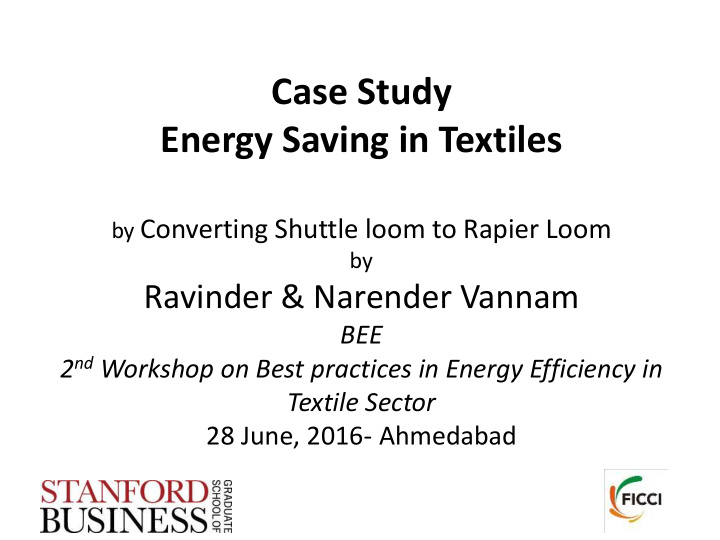



Case Study Energy Saving in Textiles by Converting Shuttle loom to Rapier Loom by Ravinder & Narender Vannam BEE 2 nd Workshop on Best practices in Energy Efficiency in Textile Sector 28 June, 2016- Ahmedabad
Awarded Gold Medal by DST-Dept. of Science &Technology – Govt. of India and Lockheed Martin - USA in India Innovation Programme.
3
4
Warp- Weft ( Tana-Bana) Textile-saving 5
Basic Motions of Loom Textile-saving 6
Basic Motions of Loom Textile-saving 7
RAPIER LOOM Textile-saving 8
Technology Description • We have designed & developed Updation Kit for converting Shuttle loom to Rapier Loom. Save electricity Boost Improves the and reduce CO 2 Productivity by Quality emission by 20% 30% 9
In-Situ upgradation to Rapier Loom. We have introduced Dwell mechanism. Rapier stops at end of shed. Less wear & tear Can upgrade the No need to / breakages Loom without remove Looms in No down time for shifting workshed setting. 10
Types of Rapiers Rapier Double Single & Flexible Rigid With Without Dwell Dwell 11
Types of Rapiers • Single Rigid Rapiers are not very popular. • Double Flexible Rapiers are used in converting Shuttle loom to Rapier Looms. • Differences of With Dwell & Without Dwell Rapiers are as follows: Description With Dwell Without Dwell 1 Crank End to end of Loom , distance 6 inch 12 inch 2 Rapier travel Rapier stops(dwell) at end Rapier overtravels outside of shed shed 3 Speed of Loom, productivity Can be increased Can’t be increased 4 Wear of reciprocating parts Wear is less Wear is more 5 Breakdown Less More 6 Maintenance cost Less Very high 7 Distance between 2 looms No need to shift the existing Needs more space. Hence Looms Looms need to be shifted. 8 Initial cost Marginally More Less 9 Life of Rapier kit 3 years 6 months 12
Types of Rapiers • Technical Recommendation: • Hence looking at the advantages of Rapier with Dwell , it is recommended to use the same while upgrading Shuttle loom to Rapier loom. • Rapier without Dwell is not recommended due to recurring maintenance problems. 13
In-Situ upgradation scheme 14
In-Situ upgradation scheme http://ministryoftextiles.gov.in/sites/default/files/news-mar/index.html#features/3 15
Developement • Special Cam Mechanism with Dwell Video Wooden Prototype Actual Cam machined on CNC 16
Technology - benefits • Owner- save approx. 20% energy required in Power loom. - Increase the productivity by 30% - Improve Quality of the Fabric due to less stoppages. • Operator-Reduce noise levels by 10%. -Improve Ergonomics of machine . Less fatigue on operator. - Improved safety: Existing Flying shuttle may leads to fatal accidents - Women can also operate the upgraded Loom & hence empowers the women. 17
Technology - benefits • Society-Save Natural Resources like, Wood being used in Shuttle, Picking Arms. • This will be cost effective to small players in : Sircilla, Kadakandla, Warangal-Telangana, Nagari, Hindupur-AP, Bhiwandi, Solapur, etc. in Maharashtra, who can’t afford new machines. • Our Technology will be ray of hope for poor weavers. • Our solution is ¼ cost of China loom & 1/10 cost of European loom. 18
Technology – benefits Energy & Environmental Savings per Powerloom/year • Energy: 1MWH, • Saving in Rs: 50,000, Pollution avoided & hence combating climatic change: CO 2 : - 3Ton-GreenHouse Gas-Global warming SO 2 : - 16Kg- Acid rain polluting waterbodies NOx : -8Kg- Carcenogenic Gas Note: 1unit=1KWH=1kg of CO 2 : =6gm of SO 2 : =3gm of NOx 1 unit saved = 3 units generated at Thermal power station Reference: pg183 LEED 2011 for India www.igbc.in 19
Technology – benefits Operating cost Savings per Powerloom/year • Electricity cost savings: Rs.50,000/- • Material cost savings: Pirn winding m/c, operators productivity increase • Simple payback period: 1.7 year - without subsidy 4-5 months with subsidy • ROI : 59% - without subsidy : 90% with subsidy 20
Energy,Pollution & Population Key levers in the Economy CO 2 = People x GDP x Energy x CO 2 Emission person unit GDP Unit Energy Population Std.of Energy intensity CO 2 intensity living Eff.of economy energy source
IP Status 23
Key Resources Our Team Ravinder Vanam: Qualifications : B.E.Mech. Walchand College of Engineering., MBA, Certified Energy Auditor- BEE, Professional Experience: • Worked for 3 decades in Industry • Did Energy Audits in various Industries resulting in lots of Energy saving. 24
Benefits Upgrading the powerlooms with our Technology provides considerable cost saving & Environmental benefits over any other alternatives. Carbon Footprint of Cloth will be reduced drastically. Trees are saved by avoiding use of Shuttle which is made of fine wood. By reducing Energy requirement at DSM-Demand side management, Investment in new Power plants will be avoided, saving our precious Natural resources like , Forests , Water etc. 25
Awards 26
Award ceremony at New Delhi 27
NEW update • the Innovation got included In-situ upgradation pilot scheme w.e.f.1.4.2016 • 50% Central Subsidy for upgradation. • Further details are yet to come. 28
Dr. Kavita Gupta IAS, Textile Commissioner declares In-Situ Scheme on 28.3.2016 at Bengaluru 29
Way forward • Got the Innovation included In-situ upgradation pilot scheme. • Get support from State Govt. • Funding by Banks. • Get Green Climatic Funds for GAP funding. 30
BEE guidance material Paper 4 - Textiles 31
BEE guidance material Paper 4 - Textiles 32
BEE guidance material Paper 4 - Textiles 33
BEE guidance material Paper 4 - Textiles Please add details of different types of weaving machines like : 1. Shuttle loom 2. Projectile Loom – ( Sulzer ) 3. Rapier loom 4. Air Jet loom 5. Water jet loom etc. And their Energy efficiency studies . 34
Thank you! Any Questions ???? Ravinder Vanam – 07036199102 Narender Vanam – 09224973138 bharatrapier@gmail.com www.srisaitextileconsultancy.webs.com 35
Recommend
More recommend